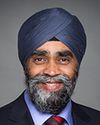Thank you for giving me the opportunity to present the supplementary estimates (B) for the Department of National Defence and the Communications Security Establishment.
Our allies and partners, and Canadians, know that the defence team is always here for them, ready to answer the call at any given moment.
Our Canadian Armed Forces assisted with record snowfalls in Newfoundland as well as responded to wildfires all the way into Australia. They helped bring Canadians home safely from China and elsewhere, as they mobilized to establish a safe and comfortable quarantine space at CFB Trenton in the face of COVID-19.
That is just in the first two months of this year. As you know, it has been extremely busy for us.
These events all underscore the need for a strong and agile defence team. It is our job to make sure that the team has the support they need to be effective. That is why my number one priority has always been to look after the women and men of our defence team in the Canadian Armed Forces and also their families.
Two and a half years into Canada's defence policy, “Strong, Secure, Engaged”, we are moving forward with our plan to support our people so that they can do the challenging jobs that we ask of them. Through these estimates, we are requesting approximately $796.9 million to continue implementing SSE. The majority of that funding relates directly to the care of our people.
We take our responsibility to take care of our members and their families very seriously. That is why we stood up the Canadian Armed Forces transition group to support ill and injured Canadian Armed Forces members and to ease transition for our members, our veterans and their families.
We also enhanced tax relief for Canadian Armed Forces members deployed on international operations, to recognize them for their hard work and to ease some of the stress for them and their families.
Our reservists also form a very critical part of our defence team. They help with flood relief efforts and also in fighting fires. They do all of this often while maintaining a career outside the military. They too deserve our full support. That is why we made sure that reservists take home the same day's pay for the same day's work as their regular force colleagues.
We also recognize how challenging it can be for the families that serve alongside our members. It is one of the reasons that we are working through Seamless Canada with provinces and territories to make relocation easier. We are helping to give military spouses dedicated access to jobs with national employers in the private and public sectors through the Military Spousal Employment Network.
All the while, we are focused on changing the defence team culture to make sure that the organization is more welcoming, equitable and reflective of the Canadians that we serve. That is why we apply a gender-based analysis plus lens during the development of our programs and policies, to enhance our capabilities to make us more responsive to the needs of our workforce and the people who are also called upon to protect. It is why we are working hard to recruit more women into our forces.
Since 2015, we've doubled women's enrolment in the reserve force and increased enrolment by 72% in the regular force. Women now make up 15.9% of the Canadian Armed Forces membership.
In NATO, where the average of the active duty women across NATO nations is at 11%, Canadian women are also taking on very important leadership roles as well. There is more work to be done but we will not waver in our commitment to our success.
Part of that work also means recognizing that the Canadian Armed Forces has not always been a welcoming and safe environment for everyone. These estimates include $148.6 million for defence team members who were victims of sexual assault, harassment and discrimination based on gender or sexual orientation. We hope that this settlement will help bring the survivors closure and healing.
We continue to work towards a respectful work culture that is free from harassment and discrimination. The department is also working with our government partners to implement the final settlement agreement of the LGBT purge class action lawsuit. We have evolved our military justice system to better deal with harmful behaviours through Bill C-77, which received royal assent last summer. We will not stop until all of our members feel valued, cared for and supported.
Taking care of our people also means equipping them to do their jobs. SSE provides a road map and carves the funding out of our fiscal framework to allow us to do this.
We have already completed or started more than two-thirds of the projects that were outlined in our defence policy. These projects not only ensure that the defence team is ready to meet modern security demands, but they also have a significant impact on the Canadian economy. Taking the joint support ships, for example, to date under that project, we have awarded contracts that contribute close to $950 million to Canada's GDP. This maintains close to 740 jobs annually. We have selected the design of our new Canadian surface combatants, modernizing our current Halifax class frigates. We also launched the second of six new Arctic and offshore patrol ships for our navy.
Through these estimates, we are requesting $490.8 million to advance many more capital projects, such as upgrading capabilities on our helicopters, ships, planes and submarines; procuring new surveillance capabilities through satellite and space-based technologies; and modernizing equipment, facilities and our infrastructure.
Our government is committed to reducing our emissions to help reduce the impact of climate change. It is why all of our defence infrastructure projects are done with an eye towards greening defence. We have built LEED silver standard or equivalent armouries in Halifax, Saint-Hubert and Sainte-Foy. Investments like these have helped to reduce our greenhouse gas emissions by 32% from 2005 levels.
Our investments also produce economic benefits for communities across Canada. These are investments like the Nanisivik naval facility, and upgrades to runways in Inuvik and Goose Bay, which increase access into these communities and bring economic opportunity.
Just as we partnered with Treaty 1 first nations to transfer the Kapyong lands, we are working closely with indigenous partners as we look to enhance our ability to operate in the north. We have collaborated with more than 25 indigenous partners on the new whole-of-government Arctic and northern policy framework. We are also advancing research and development, investing in innovation to help solve key challenges that will benefit all, including our northern and indigenous communities.
The Canadian Rangers are a direct link to these communities. As Canada's eyes and ears in the north, they are instrumental in both Arctic sovereignty and search and rescue operations. The Canadian Armed Forces will continue to work with the Canadian Rangers to defend Canada's rights and sovereignty, to keep the north safe and well defended and to ensure that the Arctic remains a region of peace and stability.
In this ever-evolving security environment, we need every advantage to help us identify, prepare for and defend against threats to our country. That is why our government is committed to building on the successes of the Communications Security Establishment and the Canadian Centre for Cyber Security. Through these estimates, we are requesting a funding transfer so that CSE will keep pace with advancement in quantum technology and exercise new authorities to conduct cyber operations to support national defence.
Even with all the right people, all the right resources and all the right technology, Canada cannot tackle modern defence challenges alone. We cannot be on an island of stability in an ocean of turmoil. Eventually, the negative ripples will reach our shores. That is why we are committed to being a reliable partner and a good global citizen.
We continue to collaborate with our closest partner, the United States, on continental defence, and we are modernizing NORAD.
We are pleased that the Iraqi government has also reaffirmed its support for NATO's continued presence and its training mission, which Canadian Major-General Jennie Carignan proudly leads.
Through these estimates, we are requesting $132.5 million to continue supporting NATO assurance and deterrence measures.
Canada leads a battle group in Latvia and supports NATO air policing in Romania. We also contribute to the standing NATO maritime group and NATO's high-readiness force. We have rejoined the NATO airborne early warning and control force, known as AWACS.
We also play a very important role with the United Nations. Last summer, we completed the air task force deployment to the United Nations peacekeeping mission in Mali. We continue to maintain staff officers in support of that mission. We also began providing cross-mission tactical airlift support to two other UN missions as part of Operation Presence in Uganda.
The funding we are requesting today will also allow us to keep our people at the centre of everything we do. Every day they represent Canada with professionalism, leadership and excellence. For that we owe them the right tools to get the job done as well as our unwavering support and our most profound gratitude.
Madam Chair, the defence team is here to answer the questions that you and the committee members may have. We are ready to answer these questions, but if we happen to not have all the facts at hand, we will make sure that we provide them to you at the earliest convenience.
Thank you.




